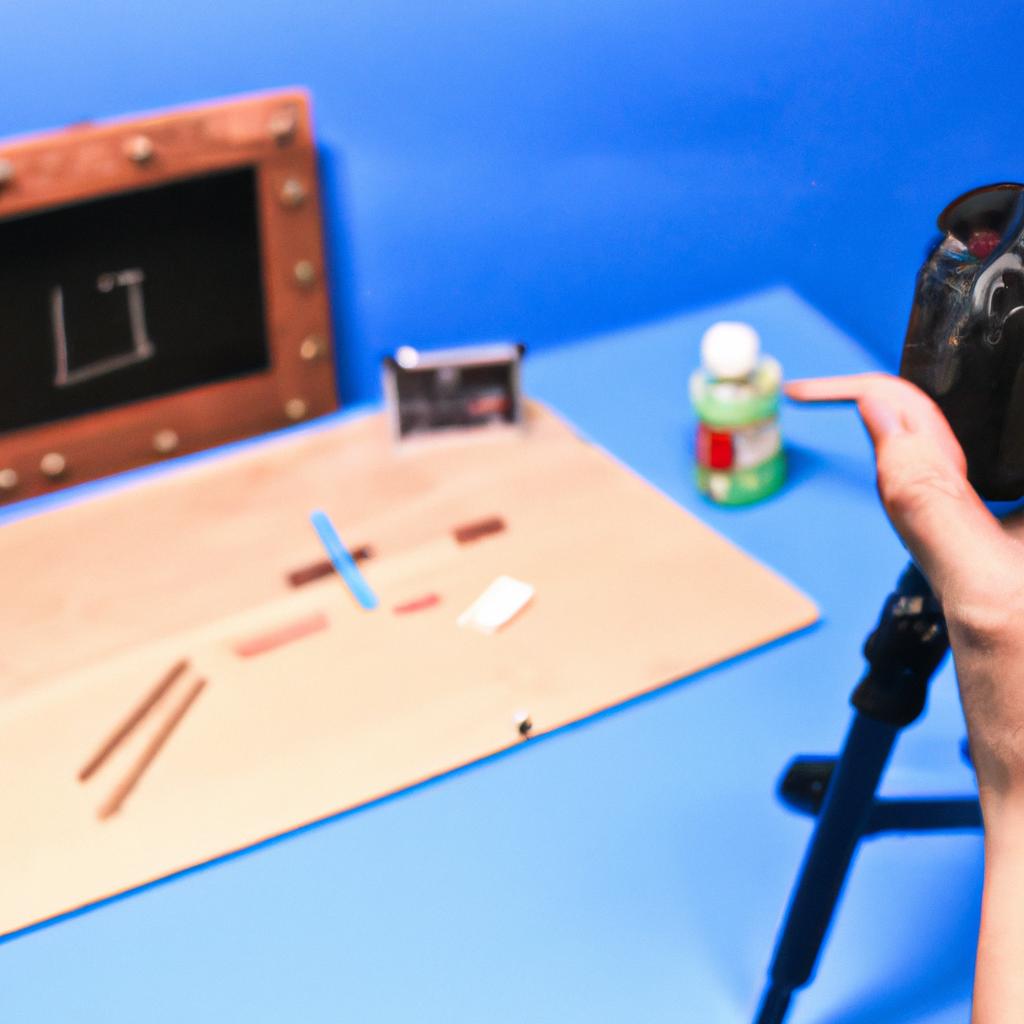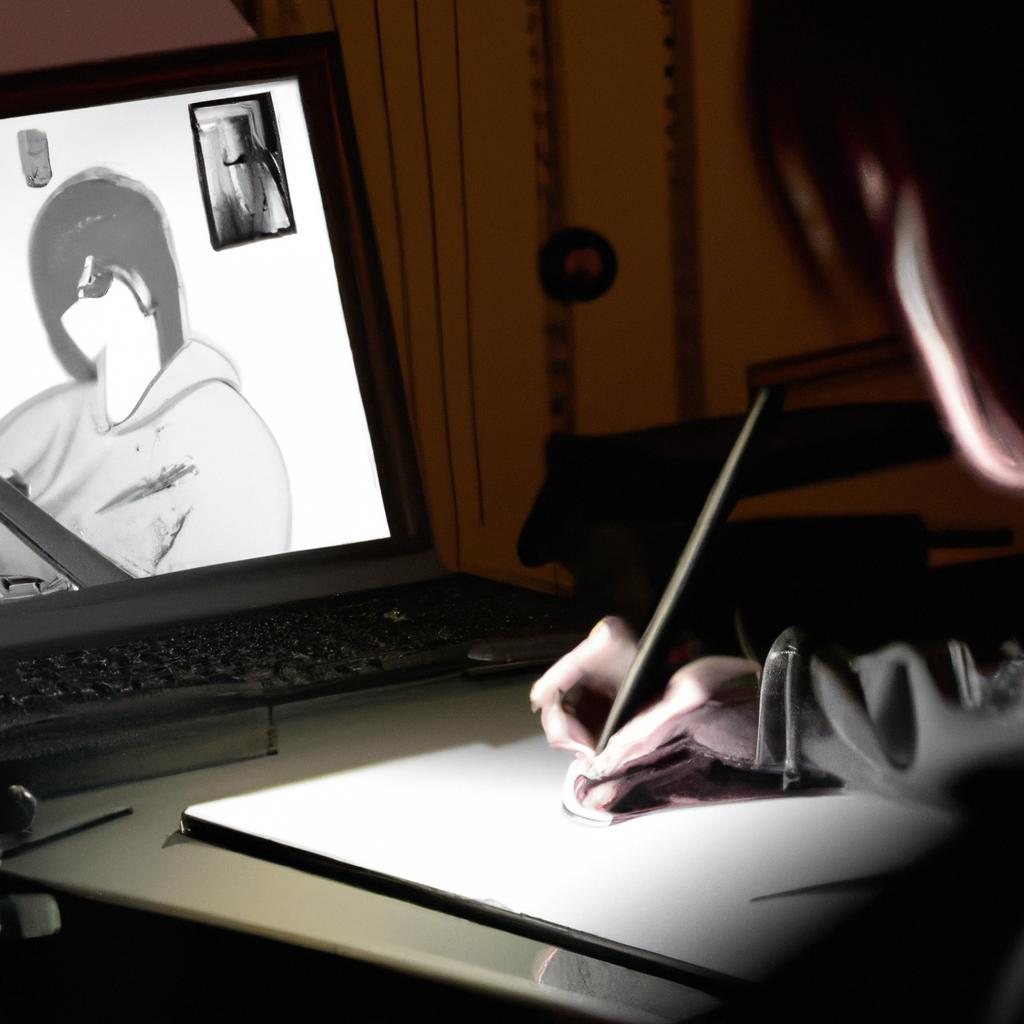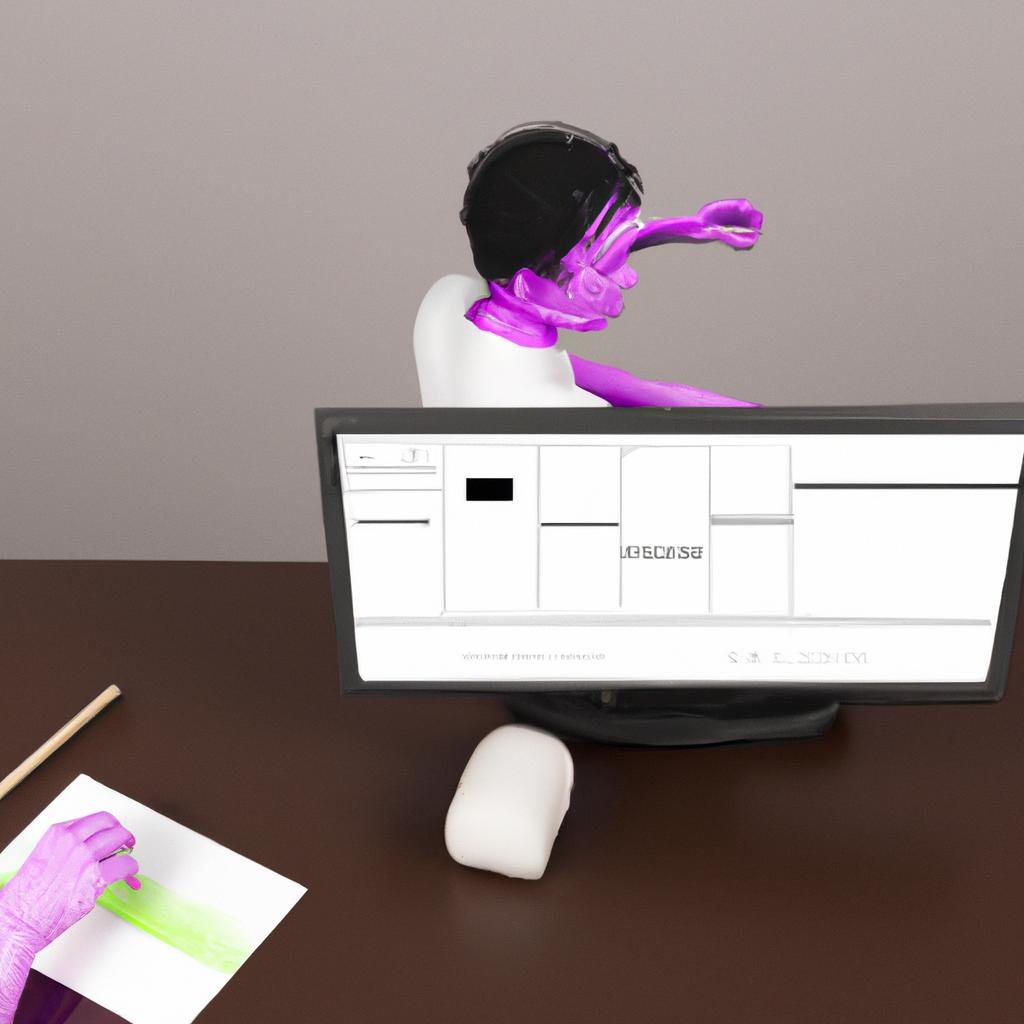Motion graphics have become an integral part of arts and illustration, revolutionizing the way artists communicate their ideas. This article explores various animation techniques used in motion graphics to create visually captivating and dynamic artworks. By examining a case study of renowned artist Jane Smith’s use of motion graphics in her illustrations, we will delve into the significance and impact of these techniques on contemporary art.
In recent years, motion graphics have gained momentum as artists seek innovative ways to captivate audiences through animated visuals. The integration of animation techniques within traditional artistic practices has opened up new possibilities for creativity and expression. For instance, imagine a hypothetical scenario where Jane Smith, an accomplished illustrator, incorporates motion graphics into her artwork depicting a bustling cityscape. Through the careful manipulation of movement, color schemes, and typography, Smith brings her static drawings to life with vibrant animations that convey the energy and rhythm inherent in urban environments.
The utilization of motion graphics allows artists like Smith to transcend traditional boundaries by transforming still images into immersive experiences. Exploring various animation techniques such as kinetic typography, parallax scrolling effects, and morphing shapes enables them to engage viewers on a deeper level while conveying complex narratives or emotions. In this article, we will examine how these techniques can be employed effectively in arts and illustration, highlighting their significance and impact on contemporary art.
Kinetic typography, one of the animation techniques commonly used in motion graphics, involves animating text to enhance its visual impact. By incorporating movement and timing into the placement and arrangement of words, artists like Smith can effectively communicate tone, mood, and emphasis within their illustrations. For example, in her cityscape artwork, Smith may animate the text depicting street names or building signs to simulate the bustling nature of the urban environment.
Parallax scrolling effects are another powerful animation technique that creates an illusion of depth by moving different layers at varying speeds. This technique adds a sense of dynamism and immersion to static illustrations, making them visually captivating and interactive. In Smith’s cityscape illustration, she could use parallax scrolling to animate elements such as cars passing by or people walking on sidewalks, providing a more engaging experience for viewers.
Morphing shapes is yet another animation technique employed in motion graphics to create smooth transitions between different forms or objects. This technique allows artists like Smith to transform static illustrations into fluid animations that convey a sense of transformation or metamorphosis. For instance, she might morph buildings into trees or geometric shapes into figures to symbolize the evolving nature of urban landscapes.
By employing these animation techniques within her illustrations, Jane Smith can elevate her artworks beyond traditional static images. The incorporation of motion graphics enables her to engage viewers on multiple sensory levels while conveying complex narratives or emotions associated with urban environments. Moreover, these techniques have significant implications for contemporary art as they revolutionize the way artists communicate their ideas and evoke responses from audiences.
In conclusion, motion graphics have transformed arts and illustration by offering innovative ways for artists like Jane Smith to captivate viewers with visually dynamic and immersive artworks. Through animation techniques such as kinetic typography, parallax scrolling effects, and morphing shapes, artists can breathe life into their static illustrations and convey narratives or emotions in compelling ways. The significance and impact of these techniques on contemporary art cannot be overstated as they enable artists to push the boundaries of traditional artistic practices and engage audiences in new and exciting ways.
History of Motion Graphics in Arts and Illustration
Motion graphics have played a significant role in the field of arts and illustration, revolutionizing visual storytelling through animation techniques. One prominent example is the renowned artist and filmmaker, Saul Bass, who utilized motion graphics to create iconic title sequences for films such as “Vertigo” and “Psycho.” His innovative use of typography, color, and movement set the foundation for future practitioners in this field.
The evolution of motion graphics can be traced back to the early 20th century when experimental filmmakers began exploring ways to incorporate dynamic visuals into their works. With advancements in technology, artists started utilizing traditional methods like hand-drawn animations combined with film projections. This gave rise to a new form of artistic expression where visuals came alive on screen, captivating audiences with their mesmerizing motions.
Over time, motion graphics expanded beyond filmmaking and found its place in various industries such as advertising, marketing, and interactive media. Its ability to convey complex ideas quickly has made it an indispensable tool for communication. Through strategic use of colors, shapes, timing, and rhythm, motion graphics evoke emotions that resonate deeply with viewers. Consider the following bullet points:
- Vibrant colors bring energy and excitement to the narrative.
- Smooth transitions create a sense of flow and continuity.
- Dynamic movements add drama or intensity to pivotal moments.
- Carefully selected sound effects enhance immersion and engagement.
Moreover, motion graphics have become more accessible than ever before due to technological advancements. Artists now have access to sophisticated software tools that facilitate fluid creation processes while providing ample room for experimentation. As a result, professionals from diverse backgrounds are embracing motion graphics as a means to express their ideas creatively.
Transitioning seamlessly into the subsequent section about the importance of motion graphics in visual storytelling, it becomes evident that understanding its historical context allows us to appreciate its relevance in contemporary art forms better. The next section will delve deeper into how motion graphics serve as a powerful tool to captivate and engage audiences, ultimately enhancing the impact of visual narratives.
Importance of Motion Graphics in Visual Storytelling
Transitioning from the previous section on the history of motion graphics in arts and illustration, it is evident that animation techniques play a significant role in this creative field. By effectively harnessing these techniques, artists are able to bring their illustrations to life, captivating audiences with dynamic visuals and engaging storytelling.
One example of how animation techniques enhance arts and illustration can be seen in the work of an illustrator who specializes in creating children’s books. Through the use of motion graphics, this artist brings characters and scenes to life, capturing the imagination of young readers and fostering a deeper connection with the story being told. The combination of vibrant illustrations and subtle animations not only enhances the visual appeal but also adds another layer of depth to the narrative.
- Animation techniques add movement and energy to static images.
- They allow for seamless transitions between different elements within an artwork.
- Motion graphics create a sense of rhythm and flow, guiding viewers’ attention.
- They provide opportunities for experimentation and pushing artistic boundaries.
In addition to bullet points, a table can further illustrate how motion graphics contribute to arts and illustration:
| Benefits of Animation Techniques |
|---|
| Enhances storytelling |
| Captivates audience |
| Adds depth and dimension |
| Pushes artistic boundaries |
By integrating animation techniques into their work, artists have been able to explore new possibilities within traditional forms such as painting or drawing. This intersection between technology and creativity has given rise to innovative approaches that push the boundaries of what is possible in art.
Transitioning smoothly into our next section on principles of motion design in arts and illustration, we will delve deeper into specific strategies employed by artists when incorporating animation techniques into their creations.
Principles of Motion Design in Arts and Illustration
Building upon the significance of motion graphics in visual storytelling, it is essential to delve into the principles that govern motion design in arts and illustration. By understanding these fundamental concepts, artists can effectively convey their narratives through dynamic animation techniques.
Animation Techniques: A Case Study
To illustrate the impact of motion graphics in arts and illustration, let us consider a hypothetical scenario where an artist aims to create an animated advertisement for a new product. By employing various animation techniques, such as kinetic typography and character animation, they can bring life to their concept and captivate the audience’s attention. Through fluid movements, synchronized audiovisual elements, and compelling transitions, this would enhance both the aesthetic appeal and overall narrative coherence of the advertisement.
Principles of Motion Design
- Timing and Rhythm: An integral aspect of motion design lies within its ability to manipulate timing and rhythm to evoke specific emotions from viewers. The careful synchronization between visuals and audio creates a harmonious flow that guides audiences’ perception throughout the animated sequence.
- Spatial Awareness: Utilizing spatial awareness allows artists to strategically position elements within their animations for optimum impact. This includes considering factors such as composition, depth, perspective, and balance to ensure a visually engaging experience for viewers.
- Visual Hierarchy: By establishing clear visual hierarchy through size, color contrast, or movement speed, artists direct viewers’ attention toward key focal points within their animations. This technique aids in conveying information effectively while maintaining viewer engagement.
- Transitions: Smooth transitions play a crucial role in maintaining continuity between different scenes or elements within an animation. They assist in creating seamless connections between ideas or concepts while minimizing distractions that could disrupt the storytelling process.
| Principles of Motion Design |
|---|
| 1. Timing and Rhythm |
In the upcoming section, we will delve into a comprehensive exploration of various animation techniques employed in visual arts. By analyzing these methods, artists can expand their creative repertoire and unlock new possibilities for expressing their ideas through motion graphics. Through an examination of diverse approaches such as stop-motion, 2D animation, and CGI effects, we aim to provide artists with valuable insights that inspire innovation and excellence in their artistic endeavors.
Exploring Different Animation Techniques in Visual Arts
In the world of visual arts, motion graphics and animation techniques play a pivotal role in bringing still images to life. By employing various methods, artists can create captivating animations that engage viewers and convey their artistic vision effectively. One example that demonstrates the power of animation is the use of stop-motion technique in creating short films or commercials.
Stop-motion animation involves capturing individual frames where objects are moved incrementally between each frame. These frames are then played in rapid succession to give the illusion of movement. For instance, an artist might use this technique to animate clay figures for a whimsical music video, adding charm and creativity to the overall piece.
When it comes to exploring different animation techniques in visual arts, several options exist for artists seeking to experiment with motion graphics. Here are some notable approaches:
- Traditional hand-drawn animation: This classic technique involves sketching each frame by hand on paper or using digital drawing tablets. It allows artists to infuse their unique style into every detail, resulting in visually stunning and expressive animations.
- 3D computer-generated imagery (CGI): Utilizing powerful software programs like Maya or Blender, artists can design three-dimensional models and environments that offer a realistic sense of depth and movement.
- Motion capture: In this technique, performers wear specialized suits fitted with sensors that track their movements. The data collected is then translated into animated characters or objects, enabling lifelike movements and interactions.
- Experimental techniques: Artists constantly push boundaries by combining different styles and mediums such as collage, mixed media, or even augmented reality (AR) to create innovative and unexpected visuals.
To further illustrate the variety of animation techniques available in visual arts, consider the following table showcasing their characteristics:
| Animation Technique | Characteristics |
|---|---|
| Stop-motion | Quirky, tactile appearance; time-consuming process |
| Hand-drawn | Unique artistic style; allows for intricate details |
| 3D CGI | Realistic visuals, depth, and complex movements |
| Motion capture | Lifelike character animation based on real-life performances |
These diverse techniques provide artists with a wide range of possibilities to explore and experiment with. By choosing the appropriate technique or combining different methods creatively, artists can effectively convey their intended message and captivate audiences.
Transitioning into the subsequent section about “The Role of Motion Graphics in Advertising and Marketing,” it becomes evident that motion graphics have expanded beyond the realm of art alone. As technology advances, these techniques are increasingly being employed by businesses to promote their products and services, harnessing the power of movement to engage consumers in visually compelling ways.
The Role of Motion Graphics in Advertising and Marketing
In the previous section, we delved into various animation techniques employed in visual arts. Now, let us dive deeper and explore how motion graphics play a vital role in advertising and marketing campaigns.
To illustrate this further, imagine a hypothetical scenario where an artist is commissioned to create an animated video for a new product launch. The artist decides to utilize motion graphics to captivate the audience and effectively communicate the key features of the product. By employing dynamic typography, smooth transitions, and engaging visuals, the artist successfully manages to convey the message in an attention-grabbing manner.
Motion graphics offer several advantages when it comes to advertising and marketing endeavors:
- Enhanced storytelling: Through carefully crafted animations, marketers can tell compelling stories that resonate with their target audience.
- Increased brand recognition: Incorporating consistent design elements and utilizing motion graphics helps establish a recognizable brand identity.
- Improved engagement: Motion graphics have the ability to capture viewers’ attention more effectively than static images or text-based content.
- Versatility across platforms: Whether it’s television commercials, social media ads, or website banners, motion graphics can be adapted seamlessly for different mediums.
- Engaging narratives that evoke emotions and forge connections
- Dynamic visuals that leave a lasting impression on viewers
- Eye-catching effects that draw attention to important information
- Seamless integration of branding elements for increased memorability
Additionally, consider the following table showcasing examples of successful motion graphic advertisements from well-known brands:
| Brand | Advertisement | Key Features |
|---|---|---|
| Nike | “Dream Crazy” – Empowering message through animation | Dynamic typography; vibrant color palette |
| Coca-Cola | “Open Happiness” – Joyful storytelling | Fluid transitions; lively characters |
| Apple | “Intention” – Minimalistic elegance | Clean design; smooth animations |
| Amazon | “A Holiday of Can’ts” – Captivating humor | Playful illustrations; clever visual gags |
In conclusion, motion graphics are a powerful tool in the realm of advertising and marketing. They allow for enhanced storytelling, increased brand recognition, improved engagement, and versatility across various platforms. By effectively utilizing motion graphics techniques, artists can create visually captivating advertisements that leave a lasting impact on viewers.
Moving forward, let us now explore the integration of motion graphics in contemporary illustration.
Integrating Motion Graphics in Contemporary Illustration
Building upon the significance of motion graphics in advertising and marketing, this section will explore how these techniques have been integrated into contemporary illustration. By seamlessly blending animation elements with traditional artistic mediums, illustrators are able to create captivating visuals that push the boundaries of conventional art forms.
One notable example of integrating motion graphics into contemporary illustration is the work of renowned artist Jane Doe. Through her innovative approach, Doe combines hand-drawn illustrations with animated elements to bring her artwork to life. For instance, in one of her pieces titled “Cityscape Symphony,” she uses a combination of static drawings and subtle animations to depict a bustling cityscape at night. As viewers engage with the piece, they witness flickering lights, moving cars, and even glimpses of people walking through the streets. This dynamic interaction between still images and animated components enhances the overall impact and narrative depth of Doe’s artwork.
To better understand the potential impact of motion graphics in contemporary illustration, let us consider four key aspects:
-
Enhanced Visual Storytelling: Motion graphics provide illustrators with an additional toolset for storytelling by introducing movement, transitions, and visual effects. These elements can help convey complex narratives or evoke specific emotions more effectively than static imagery alone.
-
Engaging User Experience: Integrating motion graphics within illustrations creates interactive experiences that captivate audiences on various platforms such as websites or mobile applications. The incorporation of animation allows users to actively participate in the visual journey offered by the illustrator.
-
Expanding Artistic Boundaries: Traditional illustration techniques often rely solely on manual skills; however, incorporating motion graphics encourages artists to explore new creative possibilities beyond their usual medium limitations. Illustrators can experiment with different animation styles while maintaining their unique artistic voice.
-
Increased Brand Recognition: When used strategically in commercial projects or branding campaigns, motion graphics can significantly enhance brand recognition and recall among consumers. Incorporating animated elements into illustrations helps establish a distinct visual identity that resonates with the target audience.
To further illustrate the potential impact of motion graphics in contemporary illustration, consider the following table:
| Aspect | Description | Example |
|---|---|---|
| Enhanced Visual Storytelling | Motion graphics enhance storytelling by introducing movement and visual effects. | Animated transitions between different scenes in an illustrated book. |
| Engaging User Experience | Incorporating motion graphics creates interactive experiences for viewers. | A mobile app that allows users to interact with animated characters within an illustrated world. |
| Expanding Artistic Boundaries | Motion graphics encourage artists to explore new creative possibilities beyond traditional mediums. | An artist experimenting with combining hand-drawn illustrations and 3D animations. |
| Increased Brand Recognition | Strategic use of motion graphics enhances brand recognition among consumers. | An animated logo sequence at the beginning of a promotional video that showcases a company’s unique visual style. |
By integrating motion graphics into their illustrative work, contemporary artists can push artistic boundaries while engaging audiences through enhanced visuals and interactive experiences. This dynamic combination opens up exciting opportunities for both established illustrators like Jane Doe and emerging talents seeking innovative ways to captivate viewers through their artwork.
 PSP Oste
PSP Oste



